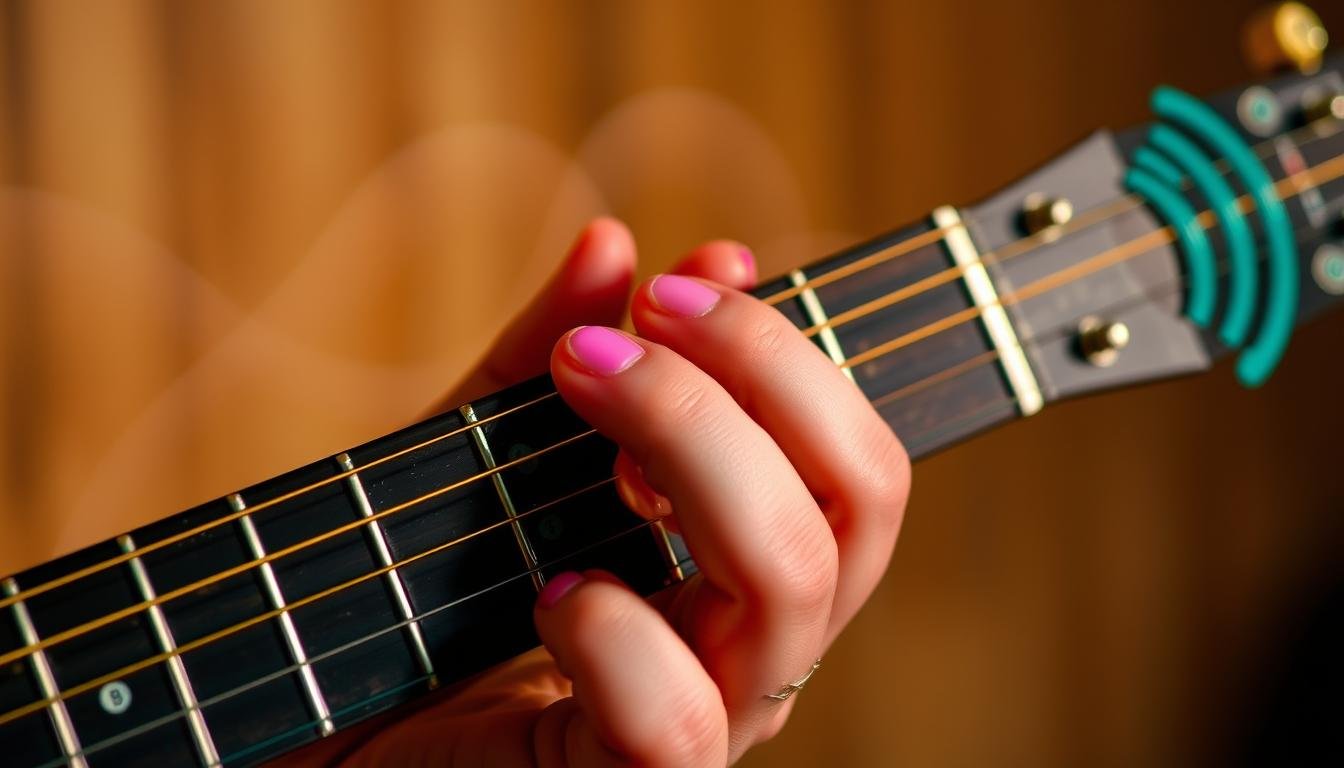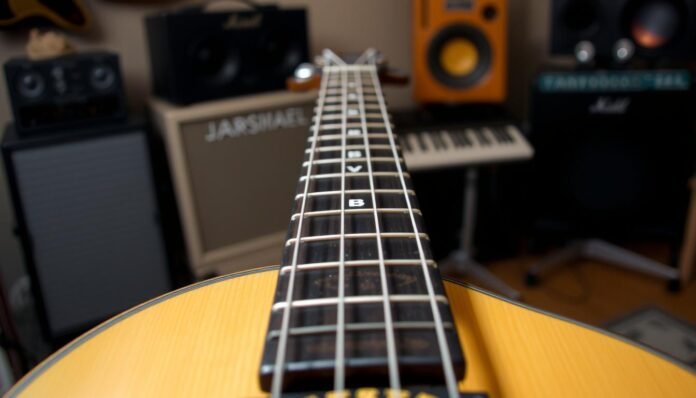The B chord is a key skill for guitar players. This guide will help you master it with ease.
We’ll cover finger placement and strumming techniques. You’ll soon be playing the B chord like a pro.
A close-up view of a guitar neck showcasing the finger positions for playing the B chord, with emphasized finger placements and strings, in a soft lighting environment. The wood texture of the guitar is highlighted, and a blurred background of a cozy music studio is visible.
Get ready to add the B chord to your guitar skills. Let’s dive in and start playing!
Understanding the B Chord
The B chord is a key part of guitar theory. It’s a triad chord comprising three notes: B, D#, and F#.
These notes form the root, third, and fifth of the B chord, which is used in many types of music.
Guitarists should know how the B chord works. This helps them play better and write songs.
Learning about the B chord can improve your guitar skills. It can help you create new sounds and play different styles.
Understanding this chord will make you a better musician. Your music will allow you to express yourself more.
How to Position Your Fingers for the B Chord
Let’s learn how to play the B chord on your guitar. This skill helps you make clear sounds and switch chords quickly.
Put your index finger on the second fret of the A string. Place your middle finger on the third fret of the D string.
Rest your ring finger on the fourth fret of the G string. Press your pinky finger on the fifth fret of the B string.
Keep your wrist straight and your elbow close to your body. This helps you press all strings evenly, resulting in a nice sound.
Arch your fingers and bend your knuckles slightly. This gives you better control when playing the chord.
Practice will help you switch between the B chord and others. Soon, you’ll be able to play many songs on guitar.
Strumming Techniques for the B Chord
Mastering strumming brings the B chord to life on your guitar. Let’s explore techniques that add rhythm and energy to your playing.
Start with basic downstrokes and upstrokes. Focus on keeping a steady rhythm.
Try different rhythm patterns with both downstrokes and upstrokes. Mix quarter, eighth, and sixteenth notes for a dynamic sound.
Smooth chord transitions are key when playing the B chord. Practice moving between B and other chords like G and D.
This is a close-up view of a hand positioned on a guitar fretboard, clearly showing the finger placement for the B chord. Vibrant colors highlight the strings. The background features an abstract representation of sound waves from the guitar, symbolizing strumming techniques with a warm and inviting ambience.
For advanced players, try muted strums and palm muting. To add depth to your B chord playing, add percussive elements.
Regular practice is vital to mastering these strumming techniques for the B chord. Have fun and be creative with this versatile chord.
Troubleshooting Common Issues
Learning the b chord on guitar can take time and effort. You might face some challenges, but don’t give up!
Practice and the proper methods will help you succeed. You’ll soon play the b chord like a pro.
Finger pain is a common issue with the b chord. The tight finger position can strain your hands.
Use good technique and take breaks to stretch. Build up your practice time slowly to increase strength.
Muted strings can also be a problem. This happens when fingers aren’t placed right or pressed too hard.
Try different finger positions to find the best spot. Learn to use just enough pressure for clear sound.
Face these issues head-on with focused practice. You’ll soon play the b chord with ease.
Keep working at it. The b chord will become a natural part of your music.
Alternatives to the Standard B Chord
The standard B chord can be tricky for guitar players. Luckily, there are easier ways to play this chord.
B-chord variations and simplified b-chord techniques can help beginners. These methods open up new possibilities for players of all skill levels.
One popular option is using barre chords. This method uses your index finger to press multiple strings at once.
Barre chords create a compact shape that’s easier to play. It requires fewer finger movements than the standard B chord fingering.
You can also try different B chord variations , like B7 or Bm7. These chords sound similar but may be easier to play.
Practice different approaches to find the best b chord for you. With time and effort, you’ll master this vital guitar chord.
Practicing the B Chord Effectively
Mastering the B chord on guitar takes practice and dedication. Targeted exercises and chord progressions help build muscle memory and dexterity.
Start with b-chord exercises focusing on finger placement—practice switching between B and chords like G, D, and E.
Gradually increase the speed of your chord transitions. Make sure your fingers are always in the correct position.
Use practice routines that put the B chord in different musical contexts. Try simple chord progressions featuring the B chord, like I-IV-V or I-vi-ii-V.
Experiment with different strumming patterns and rhythms. This helps develop a well-rounded understanding of the chord’s versatility.
Explore chord progressions that showcase the B chord in various styles. The B chord is vital in pop, rock, folk, and country.
Practising these progressions helps you master the B chord. It also gives you a deeper appreciation for its musical uses.
Be consistent and patient when practising the B chord. Dedicate time each day to these exercises and routines.
With regular practice, you’ll soon see a significant improvement in your guitar skills.
Incorporating the B Chord into Songs
The B chord is a key part of many popular songs. It’s used in rock, pop, country, and blues music.
Nirvana’s “Smells Like Teen Spirit” features the B chord in its opening riff, which gives the song its powerful and energetic sound.
Bebe Rexha’s “Meant to Be” in country music uses the B chord. It helps create the song’s catchy melody and rhythm.
The B chord is also essential in blues music. B.B. King’s “The Thrill Is Gone” uses it throughout.
You can add depth to your own songs by learning the B chord. It will help you play a wide range of music styles.
FAQ
What is the structure of the B chord?
The B chord has three notes: B, D#, and F#. Knowing this structure is important for better guitar playing.
How do I properly position my fingers for the B chord?
Place your index finger on the 2nd fret of the 1st string. Put your middle finger on the 4th fret of the 3rd string.
Your ring finger goes on the 4th fret of the 5th string. Keep your hand curved for a clear sound.
What are some effective strumming techniques for the B chord?
Mix downstrokes and upstrokes to create a rhythm for the B chord. Try different patterns like down-up-down or a 1-2-3-4 rhythm.
Practice smooth transitions between the B chord and other chords.
How can I troubleshoot common issues when playing the B chord?
If your fingers hurt or have muted strings, adjust your finger placement. Apply less pressure and make sure your strings are tuned.
Slow down and focus on building finger strength and dexterity.
Are there any alternative ways to play the B chord?
Yes, there are simpler B-chord versions for beginners. You can also try advanced barre chord techniques.
Explore different B chord positions on the fretboard to find your comfort zone.
How can I effectively practice the B chord?
Use the B chord in chord progressions, strumming patterns, and scale exercises. Regular practice will help you master the B chord over time.
How can I incorporate the B chord into songs?
The B chord is used in many popular songs. Learn songs with the B chord to improve your skills.
Study how the B chord works in different chord progressions and melodies.
you may also read : Learn the B Chord: Essential Guitar Guide for Beginners


